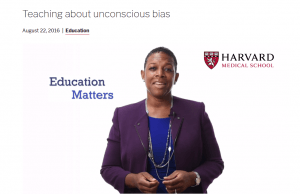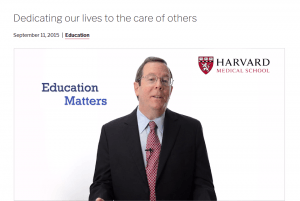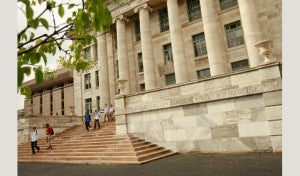 We are excited that you have chosen to join Harvard Medical School (HMS), and look forward to the contribution your efforts will bring to our very special and dedicated community of faculty, staff and students. This section of the portal will provide you with an understanding of the School’s history, mission and core commitments.
We are excited that you have chosen to join Harvard Medical School (HMS), and look forward to the contribution your efforts will bring to our very special and dedicated community of faculty, staff and students. This section of the portal will provide you with an understanding of the School’s history, mission and core commitments.
Harvard Medical School In Motion |HMS Community Values |History and Nobel Laureates | The HMS Mission & Core Commitments | HR Virtual Front Desk | HLC Work/Life Office|Harvard Affinity Groups
HARVARD MEDICAL SCHOOL IN MOTION
HMS is an amazing place made up of students, faculty and staff who collaborate by bringing fresh and exciting perspectives to the challenges and concerns within the field of medicine today. Harvard Medical School In Motion captures a snapshot of the teamwork, and as a result, the innovation that occurs within the HMS community.
![]()
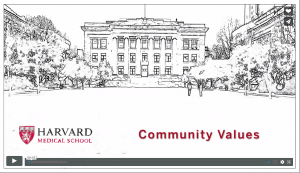 Click here to watch the video.
Click here to watch the video.
The community values initiative was designed to engage the HMS community in the development of shared values that embody how our community works together in pursuit of our institutional mission. The HMS community values statement articulates how we work and interact with each other, and what it means to be a member of the HMS community. What we do here at HMS matters, and this initiative is an opportunity for us as a community to reflect not just on what we do, but on how we do it.
We are on the cusp of life-changing breakthroughs that can improve the health of people everywhere. Helping people live longer, healthier lives is more than a goal; it’s our responsibility. We operate like no other institution. We are the very heart of medicine, with more research benches and bedsides within a 5-mile radius than anywhere else in the world. We are constantly driving vital resources, diverse thinking, and leadership into the whole body of science and medicine. We not only work toward our goals, but do so with certain core values and principles.
*******************************************************************************
WHO IS PART OF OUR COMMUNITY?
Education Matters: Teaching about unconscious bias
Education Matters: Dedicating our lives to the care of others
*******************************************************************************
To see more videos and to follow HMS on other social media channels, click below:
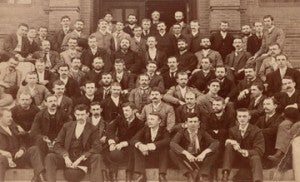
Established in 1782, Harvard Medical School began with a handful of students and a faculty of three. The faculty members consisted of Benjamin Waterhouse, professor of anatomy and surgery, John Warren, professor of the theory and practice of physic, and Aaron Dextor, professor of chemistry and materia medica (pharmacology). In 1810, the Medical School moved from Cambridge to Boston. The following year, Dr. Warren’s son, John Collins Warren, and James Jackson led efforts to start Massachusetts General Hospital (MGH) in Boston. MGH, like most hospitals founded in the 19th century, started out caring for the poor; patients who could afford medical care received it at home.
From 1816 to 1846 the Medical School was located on Mason Street. With a gift from a private bequest through the Great and General Court of Massachusetts, the School became known as the Massachusetts Medical College of Harvard University. In 1847 the School moved to North Grove Street, next door to the Bulfinch Building of MGH. In 1883 the School relocated to Boylston Street in Copley Square on the site where the new wing of the Boston Public Library now stands.
Within a few years of becoming president of Harvard in 1860, Charles Eliot established a novel curriculum at the Medical School. Admissions standards were raised, written exams and passing grades were required, new departments of basic and clinical sciences were established, a three-year degree program was introduced, and the apprenticeship system was eliminated. Harvard Medical School became a professional school of Harvard University, setting the United States standard for the organization of medical education within a university.
In 1906, the Medical School moved to Longwood Avenue in Boston where the five original marble-faced buildings of the quadrangle are still used for classrooms, research laboratories and administrative offices. At the time of the move, the Fenway was open farm and marshland. The combination of a new medical school and empty land drew hospitals to the neighborhood now known as the Longwood Medical Area.
**************************************************************
Below are individuals recognized as Nobel Laureates during their tenure at HMS. Most were recognized for their medical advances, however, the four highlighted individuals were recognized for their work with their soviet counterparts advocating for peace during the cold war.
- George Minot and William P. Murphy, 1934, Physiology or Medicine: Research on liver treatment of the anemias
- Fritz A. Lipmann, 1953, Physiology or Medicine: Identified coenzyme A and discovered basic principles of how cells generate energy
- John F. Enders, Frederick C. Robbins and Thomas H. Weller, 1954, Physiology or Medicine: Application of tissue-culture methods to the study of viral diseases, such as polio
- Baruj Benacerraf, 1980, Physiology or Medicine: Discovered genetically-determined structures on the surface of immune system cells that regulate immunological reactions
- David Hubel and Torsten Wiesel, 1981, Physiology or Medicine: Research on information-processing in the visual system
- Bernard Lown, Herbert Abrams, Eric Chivian and James Muller, 1985, Peace Cofounders with Evgueni Chazov, Leonid Ilyin and Mikhail Kuzin from the Soviet Union, of the International Physicians for the Prevention of Nuclear War
- Joseph E. Murray, 1990, Physiology or Medicine: Developed procedures for organ and cell transplantation in humans (with E. Donnall Thomas, formerly of the University of Washington)
- Linda Buck, 2004, Physiology or Medicine: Discovered odorant receptors and the organization of the olfactory system, explaining the sense of smell (with Richard Axel, Columbia University)
- Jack Szostak, 2009, Physiology or Medicine: The discovery of how chromosomes are protected by telomeres and the enzyme telomerase (with Elizabeth Blackburn and Carol Greider)
HMS MISSION AND CORE COMMITMENTS ![]()
The Harvard Medical School community is dedicated to excellence and leadership in medicine, education, research and clinical care. To achieve our highest aspirations, and to ensure the success of all members of our community, we value and promote common ideals that center on collaboration and service, diversity, respect, integrity and accountability, lifelong learning, and wellness and balance. To be a citizen of this community means embracing a collegial spirit that fosters inclusion and promotes achievement. More
For generations, HMS has fostered a culture that has excelled in medical education, clinical care, and biomedical research by adhering to core commitments. Ours is an institution dedicated to innovation in education, to scientific discovery and integrity, to diversity and professional development, and to service to humanity.
The School’s mission is to create and nurture a diverse community of the best people committed to leadership in alleviating human suffering caused by disease.
Innovation in education
Since 1782, Harvard Medical School has prepared generations of physicians for leadership roles in education, research and policy and to care for patients with integrity, skill and compassion. For over 200 years, the School has influenced and shaped the design of medical school education throughout the world. From Harvard University President Charles Elliot—who in the 19th century developed the concept of a medical school as we know it today—to the groundbreaking New Pathway curriculum of the 1980s, HMS has led a continual process of growth and innovation in education. Today, the School continues to enhance its curriculum to meet the needs of 21st century medicine by integrating clinical and basic science across the curriculum, developing new models for clinical education and engaging students in an in-depth scholarly experience.
Scientific discovery and integrity
Creativity fuels the engine of discovery at Harvard Medical School, where more than 11,000 faculty members direct research to advance the boundaries of knowledge. This work takes place on the School’s Boston campus and across the metropolitan area at 17 affiliated hospitals and research institutes. The integrity of the HMS faculty as they pursue their clinical, research and teaching missions is of paramount importance, and the challenge posed by potential conflicts of interest is one the School takes extremely seriously. Faculty members seeking guidance on the HMS policy on Conflicts of Interest and Commitment should contact the Office for Professional Standards and Integrity.
Diversity and professional development
Harvard Medical School is committed to supporting the academic careers of all 11,000 plus faculty members and to advancing professional development of its staff. To that end, the Office of Faculty Affairs helps faculty navigate promotions and appointments systems, identify career resources, and understand the governance of the HMS community. The Office for Academic and Clinical Affairs provides information and resources for faculty members working in labs, classrooms and clinics. The Office for Diversity Inclusion and Community Partnership promotes inclusive recruitment, retention and advancement of HMS faculty and supports a diverse community of HMS faculty, trainees, students and staff. The Office of Human Resources provides a vital resource for the schools professional and administrative staff.
Service to humanity
The HMS mission to alleviate human suffering caused by disease extends to all members of society and to all corners of the globe. HMS students acquire an education where the fundamental importance of compassion is continually reinforced through an extraordinary variety of community service experiences in community health centers, multiservice nonprofit agencies, schools and public health sites in Boston and around the world.
![]() The Office of Human Resources provides services to the community to support the Core Commitments of Harvard Medical School. Click here for a full directory.
The Office of Human Resources provides services to the community to support the Core Commitments of Harvard Medical School. Click here for a full directory.
WORK/LIFE INTEGRATION AT HARVARD ![]()
Harvard provides faculty, staff and post docs with comprehensive support for work/life needs. The work/life program manager on Harvard’s Longwood Campus provides you with customized resources and support for personal or professional needs to make life’s transitions a bit more manageable. You may request resources for yourself or for those you work with or manage. Below, please find a list of some of the resources available:
Work/Life Programs at a glance:
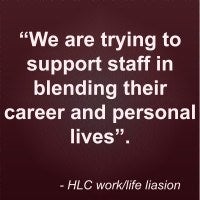
- Childcare
- Employee Assistance Program
- Adult care
- Wellness and self-care
- Discounts and services for employees
- Work/Life seminars
AFFINITY GROUPS ![]()
Harvard University has many affinity groups including the ones listed below. Click on the icon to read about group information or search online for other Harvard Affinity groups. For additional information, visit the Office of the Assistant to the President for Institutional Diversity and Equity which provides information about Links, Groups and Centers.
- African-American
- Asian Culture
- Harvard Neighbors
- Latino
- Lesbian, Gay, Bisexual, Transgender (LGBT)
- Native American
- Parents & Families
- Religion/Spirituality
- Spouses & Partners
- Women

